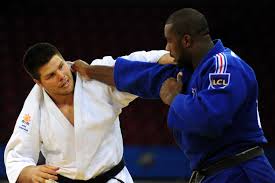Introduction
JUDO
Judo ( 柔道 jūdō?, meaning "gentle way") is a modern martial art, combat and Olympic sport created in Japan in 1882 by Jigoro Kano (嘉納治五郎). Its most prominent feature is its competitive element, where the objective is to either throw or takedown an opponent to the ground, immobilize or otherwise subdue an opponent with a pin, or force an opponent to submit with a joint lock or a choke. Strikes and thrusts by hands and feet as well as weapons defenses are a part of judo, but only in pre-arranged forms (kata, 形) and are not allowed in judo competition or free practice (randori, 乱取り). A judo practitioner is called a judoka.
The philosophy and subsequent pedagogy developed for judo became the model for other modern Japanese martial arts that developed from koryū (古流?, traditional schools). The worldwide spread of judo has led to the development of a number of offshoots such as Sambo and Brazilian jiu-jitsu.
Task
EQUIPMENTS:
Judo is competed on a mat – or tatami – measuring 14m x 14m, with a smaller 10m x 10m contest area marked within.
Judokas must each wear a gi (traditional uniform originating from the kimono and other Japanese garments). The gi must be durable enough not to easily rip and the arms and legs must be no more than 5cm above the wrists and ankles respectively when the limbs are extended. A belt must be worn which is wrapped around the jacket and tied with the traditional knot.
RULES OF JUDO:
- Judo matches take place on tatami (mats) measuring 14m x 14m, with a combat area of 10m x 10m marked out within it. Judokas (athletes) must bow before stepping onto the mat and must bow to each other before and after either practice or competition.
- Judokas must wear the appropriate gi (uniforms), that is one that is no more than 5cm above the ankles and wrists and is tied with the correct style of knotted belt.
- Bouts last five minutes (in international competition) and are won when one judoka is awarded ippon. If no ippon is awarded, the player with the highest score at the end of the bout is declared the winner. If the score are level the match is decided by a period of Golden Score then – if still not resolved – the decision of the referee and corner judges.
- Penalties are awarded for minor (shido) or major (hansoku make) infringements of the rules. Four shidos results in the award of ippon to the opponent, as does one hansoku make.
- Judokas must not employ any of the outlawed techniques, including attacking joints (other than the elbow), punching or kicking opponents, touching the opponent’s face, or intentionally injuring the opponent in any way.
_competition_area.png)
Process
TOP FIVE PLAYERS OF JUDO:
1.TEDDY RINER-FRANCE
2.TADAHIRO NOMURA-
3.RYOKO TANI-JAPAN
5.PAWEL NASTULA
Conclusion
Founder OF JUDO
- Jigorō Kanō (Japan, 1860–1938) founded judo, and established the Kōdōkan in 1882. Judo was the first Japanese martial art to gain widespread international recognition, and the first to become an official Olympic sport. Kanō was also a pioneer of international sports. Accomplishments included being the first Asian member of the International Olympic Committee (IOC). His official honours and decorations included the First Order of Merit and Grand Order of the Rising Sun and the Third Imperial Degree. He was inducted to the IJF Hall of Fame on 14 May 1999.